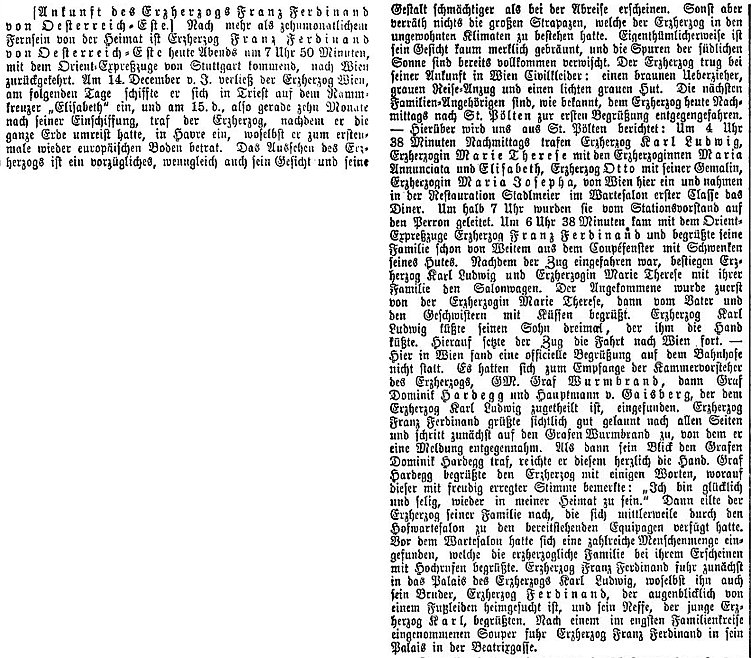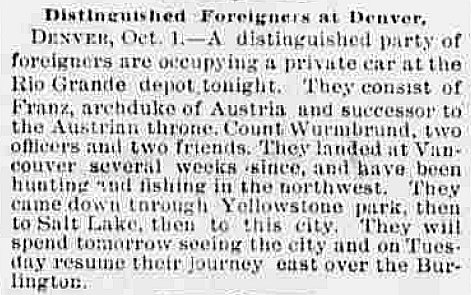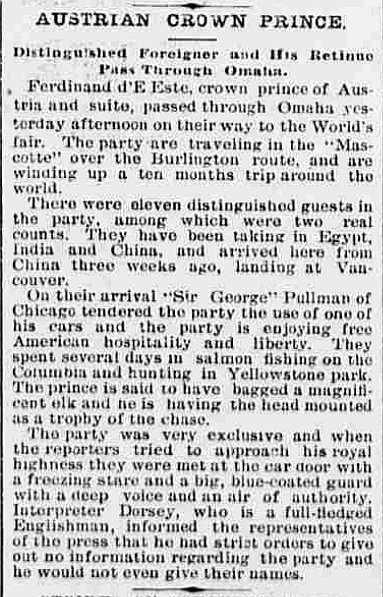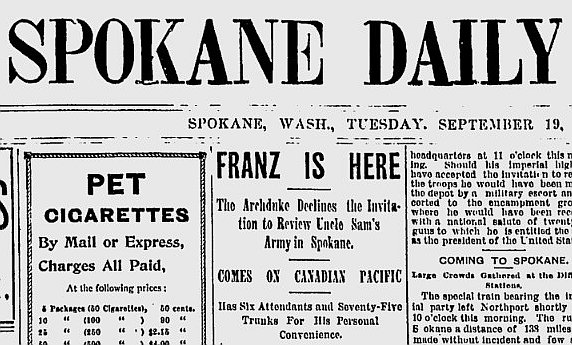As the mail still had not arrived on the morning train, I used the time up to the departure to Cinnabar to pay a visit to Captain Anderson, commander of the cavalry detachment stationed here in order to have a look at the menagerie he had assembled which was to be sent to Washington. Captain Anderson had sent me into a fit of despair the evening before when he assured me that he could have arranged for a permission to hunt some predators in the park if we had announced our wishes a few days earlier. How easy it would have been to kill one of those tin-loving bears!
The captain was living in a nicely equipped log house and knew many interesting details about the affairs in the park. His squadron has a very demanding job as it requires many guards and patrols that mainly have to look out for poachers and who have to overcome many dangers given the audacity of the poachers. A poacher was just recently relieved of a nice pony that was standing near the log house.
The menagerie was small but counted among it many remarkable pieces, thus a porcupine, a young buzzard, a badger-like animal unknown to me, three rather tame beavers that could be taken out of the cage and wandered around freely. In an iron cage sat a black bear that had been caught only a few days before and was to undertake a journey to Washington. Four delightful wapiti calves were totally tame, and came running on call, sniffing us curiously, while a fox fled into its artificial cave only to peek out of a tube with a cunning glance from time to time but immediately retiring at every approach.
During the morning some caravans of „sour dough tourists“ arrived which refers to the families that move through and now out of the park with a fully packed wagon, with their children and their stuff. We had encountered several of them already on the first day of our tour. The vehicle, their baggage and the passengers showed clearly visible marks of their gypsy-like roaming. The way these nature lovers visit the park is without doubt a very strange one and a hardly comprehensible way for us to enjoy the summer time. Any demands for comfort these travelers may have to forsake, and whether they find compensation for their many deprivations of their exhausting journey in their boundless existence is dependent on the favor of hazard and the weather’s caprices and thus can not be predicted but seems to be the case.
On the small square I then inspected a cavalry detachment, about half a squadron that performed exercises to an officer’s command. The troop exercised developments and movements that were a bit more complicated than those used at home. The development of a skirmish line where the carbine is grabbed while mounted seems to be one of the most important evolutions. The horses were noticeably tall, strong and also good, mostly white horses. The riding of the soldiers and the rough treatment of the horses I found less sympathetic. The riders wore standard dark-blue uniforms with yellow lacing on the pants and gray slouch hats and tall heavy boots. The armament consisted of saber, revolver and carbine. The latter and the saber were attached on the saddle.
To Cinnabar we came faster this time than the outward journey as the route was in a better condition and was mostly downhill. In this place we had to wait for a long time for the departure of the train of the Northern Pacific Railroad which would take us to Butte City by the way of Livingston. We then intend to travel on to the center of Mormonism, Salt Lake City, our next destination.
During the waiting time in Cinnabar we spoke with an old Saxon who had run away from his homeland to lead a free life in America as a hunter and trapper that apparently pleased him very much. Currently the man engages in a very brisk trade in bear furs and fossilized wood. With special enthusiasm he told us from his hunting expeditions on which he shoots the game emerging from the park but became very agitated when I asked him whether he was married and professed himself as a confirmed bachelor (Hagestolz).
Due to a happy coincidence, I was able to see the most audacious female rider of the area who is able to tame even the most intractable and wild horse, but has been quite neglected by nature as far as beauty and female grace are concerned.
In Livingston we had to use our Pullmann Car also as our night’s lodging as the train to Butte City was only to arrive towards 4 o’clock in the morning. The former city is a known trading place for furs and hides. In the shops one may buy the following: puma, bear, wolf, fox, cat and marten furs, buffalo hides, numerous antlers among them capital ones from wapiti and black-tail deer as well as from mountain sheep. Furthermore a lot of Indian curiosities such as weapons, jewellery and various products of the local industry.
The prices demanded by the merchants were completely outrageous. Furthermore we had to accept it as a kind of grace that they sold us the desired piece for our good money or even receive some sort of packaging. A simple Indian shawl cost 10 dollars, a badly stuffed buffalo head 600 dollars and a pair of wapiti antlers up to 200 dollars. Still our shopping craze was great as we had found many beautiful objects.
When I sent two of my gentlemen with all the necessary attestations and certifications to the post master in the evening and asked him to hand out my mail here in Livingston that had arrived at almost the same time as we and was addressed to Mammoth Hot Springs Hotel, I had to experience another proof of American unfriendliness that was very detrimental for our mood. Even though the gentlemen also presented a letter from the post master at Mammoth Hot Springs Hotel in which he asked his colleague to hand us out the late-arriving mail which was just then laying on the counter so that individual addresses could be read and one could note that among the letters there were also some whose quick reception was important for me, the impolite post master did not want to give us our mail at any price and insisted to send it on to the place of address despite all our means used to change his opinion.Finally he put on his hat and left his office without a word.
Links
- Location: Livingston, Montana, USA
- ANNO – on 27.09.1893 in Austria’s newspapers.
- The k.u.k. Hof-Burgtheater is playing the drama „Der Meister von Palmyra“. The k.u.k. Hof-Operntheater is performing the opera „Romeo und Julie“.




